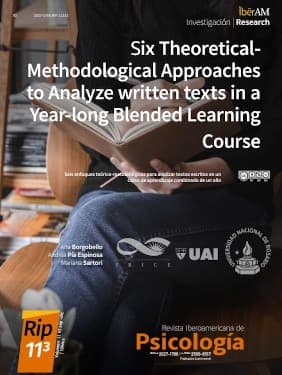Six theoretical-methodological approaches to analyze written texts in a year-long Blended Learning cours
Six theoretical-methodological approaches to analyze written texts in a year-long Blended Learning cours
Main Article Content
Virtual environment interaction has been studied from different theoretical-methodological approaches. The purpose of this paper is to describe the characteristics of written texts in a blended learning course, and to analyze six theoretical systems that contrast them with data. The collected data come from all the texts written in Moodle by the teacher in a year-long course. The variables were set up from six approaches (coding systems): (a)- Communities of inquiry; (b)- Teaching assistance dimensions; (c)- Macro and micro-scripting; (d)- Twelve ways of teaching; (e)- Rethinking the class; and (f)- Observation record. Reliability and multivariable analyses were carried out. Results showed different consistency of approaches. The analyzed texts revealed how interaction took place and showed pedagogical issues underlying the didactic proposals. Associations among categories produced three typical groups of texts related with the different variables from theoreticalmethodological coding systems used: Cluster 1 gathered general instructions; Cluster 2 illustrated the virtual environment usage as repository; and Cluster 3 represented tutorial interactivity. Future studies should continue to explore these approaches, contrasting them with new data -and vice versa- to get a better understanding of socio-cognitive interaction among students and teachers in blended learning.
Downloads
Publication Facts
Reviewer profiles N/A
Author statements
- Academic society
- Bogotá: Corporación Universitaria Iberoamericana
- Publisher
- Bogotá: Corporación Universitaria Iberoamericana
Article Details
Aebli, H. (2000). 12 formas básicas de enseñar. Una didáctica basada en la Psicología. Madrid: Narcea.
Boelens, R., De-Wever, B., & Voet, M. (2017). Four key challenges to the design of blended learning: A systematic literature review, Educational Research Review, 22(1), 1–18. http://doi.org/10.1016/j.edurev.2017.06.001 DOI: https://doi.org/10.1016/j.edurev.2017.06.001
Borgobello, A., Mandolesi, M., Espinosa, A., & Sartori, M. (2019). Uso de TIC en prácticas pedagógicas de docentes de la Facultad de Psicología de una universidad pública argentina. Revista de Psicología, 37(1), 279–317.
https://doi.org/https://doi.org/10.18800/psico.201901.010 DOI: https://doi.org/10.18800/psico.201901.010
Borgobello, A., Peralta, N. S., & Roselli, N. D. (2010). Estilo Docente Universitario En Relación Al Tipo De Clase Y a La Disciplina Enseñada. Liberabit, 16(1), 7–17. Retrieved from http://www.scielo.org.pe/pdf/liber/v16n1/a02v16n1.pdf
Borgobello, A., Sartori, M., & Roselli, N. D. (2016). ¿Cómo interactuamos aquí y allá? Análisis de expresiones verbales en una clase presencial y otra virtual a partir de dos sistemas de codificación diferentes. Revista de La Educación Superior, 45(179), 95–110. http://doi.org/http://dx.doi.org/10.1016/j.resu.2016.06.003 DOI: https://doi.org/10.1016/j.resu.2016.06.003
Charbonneau-Gowdy, P. (2017). Moving outside the box: Researching e-learning in disruptive times. Electronic Journal of E-Learning, 15(1), 59–69. Retrieved from https://eric.ed.gov/?id=EJ1140099
Coll-Salvador, C., Bustos-Sánchez, A., & Engel-Rocamora, A. (2011). Perfiles de participación y presencia docente distribuida en redes asíncronas de aprendizaje: la articulación del análisis estructural y de contenido. Revista de Educación,354, 657–688. Retrieved from http://www.revistaeducacion.educacion.es/re354_26.html
Copertari, S., Sgreccia, N., & Fantasía, Y. (2017). Espacio de Comunidades Virtuales en la UNR. In A.H. González & M.M. Martin (Comp.). 4 Jornadas de TIC e Innovación en el aula UNLP (pp.470-475). La Plata: UNLP. Retrieved from http://sedici.unlp.edu.ar/handle/10915/65078
Curcio, J. M., Castellaro, M., & Peralta, N. S. (2018). El análisis multidimensional de datos: una aplicación al estudio de la relación entre colaboración infantil entre pares y contexto socioeconómico. Persona, 21(1), 119–135. https://doi.org/10.26439/persona2018.n021.1994 DOI: https://doi.org/10.26439/persona2018.n021.1994
Dillenbourg, P., & Hong, F. (2008). The mechanics of CSCL macro scripts. International Journal of Computer-Supported Collaborative Learning, 3(1), 5–23. http://doi.org/10.1007/s11412-007-9033-1 DOI: https://doi.org/10.1007/s11412-007-9033-1
Dillenbourg. P., & Jermann, P. (2007). Designing integrative scripts. In F. Fisher, I. Kollar, H. Mandl, & J. M. Haake (Eds.). Scripting Computer-Supported Collaborative Learning. Cognitive. Computational and Educational Perspectives (pp. 275–302). New York: Springer.https://doi.org/10.1007/978-0-387-36949-5 DOI: https://doi.org/10.1007/978-0-387-36949-5_16
Garrison, R.D., Anderson, T., & Archer, W. (2000). Critical Inquiry in a Text-Based Environment: Computer Conferencing in Higher Education. The Internet and Higher Education, 2(2-3), 87-105. https://doi.org/10.1016/S1096-7516(00)00016-6 DOI: https://doi.org/10.1016/S1096-7516(00)00016-6
Garrison, R.D., Anderson, T., & Archer, W. (2010). The first decade of the community of inquiry framework: A retrospective. Internet and Higher Education, 13(1–2), 5–9. http://doi.org/10.1016/j.iheduc.2009.10.003 DOI: https://doi.org/10.1016/j.iheduc.2009.10.003
Kollar, I., Fischer, F., & Hesse, F. W. (2006). Collaboration scripts - A conceptual analysis. Educational Psychology Review, 18(2). 159–185. http://doi.org/10.1007/s10648-006-9007-2 DOI: https://doi.org/10.1007/s10648-006-9007-2
Moscoloni, N. (2005). Las Nubes de Datos. Métodos para analizar la complejidad. Rosario: UNR Editora. Retrieved from https://rephip.unr.edu.ar/xmlui/handle/2133/1761
Obando-Correal, N. L., Palechor-Ocampo, A. O., & Arana-Hernández, D. M. (2018). Presencia docente y construcción de conocimiento en una asignatura universitaria modalidad b-learning. Pedagogía y Saberes, 48(1), 27–41. Retrieved from http://revistas.pedagogica.edu.co/index.php/PYS/article/view/7371 DOI: https://doi.org/10.17227/pys.num48-7371
Onrubia. J., & Engel, A. (2012). The role of teacher assistance on the effects of a macro-script in collaborative writing tasks. Computer-Supported Collaborative Learning, 7, 161–186. http://dx.doi.org/10.1007/s11412-011-9125-9 DOI: https://doi.org/10.1007/s11412-011-9125-9
Parra-Olivares, J. E. (1996). Modelo de análisis de correspondencias múltiples. Revista de Ciencias Sociales,2(2), 183–196. Retrieved from https://dialnet.unirioja.es/servlet/articulo?codigo=4276768 DOI: https://doi.org/10.31876/rcs.v2i2.24801
Raynaudo, G. & Borgobello, A. (in press). Estilos de profesores reconocidos por promover participación en el aula. Revista Intercontinental de Psicología y Educación, s.d.
Sanjurjo, L.O. (2003). Las formas básicas de enseñar. En L.O. Sanjurjo & X. Rodríguez (Eds.) Volver a pensar la clase (pp.41-132). Rosario: HomoSapiens.
Sanjurjo, L.O. (2016). La práctica como eje articulador de las propuestas curriculares y didácticas en la formación profesional. In M. Insaurralde (comp.) La enseñanza en la educación superior. Investigaciones, experiencias y desafíos (pp.195-206). Buenos Aires, Noveduc.
Turpo, O. W. (2014). Perspectiva de la convergencia pedagógica y tecnológica en la modalidad blended learning. Educación, 23(44), 67–87. Retrieved from
http://revistas.um.es/red/article/view/234261
Twining, P., Heller, R. S., Nussbaum, M., & Tsai, C.-C. (2017). Some guidance on conducting and reporting qualitative studies. Computers & Education, 106, A1–A9. http://doi.org/10.1016/j.compedu.2016.12.002 DOI: https://doi.org/10.1016/j.compedu.2016.12.002
Villasclaras-Fernández, E., Hernández-Leo, D., Asensio-Pérez, J. I., & Dimitriadis, Y. (2013). Web Collage: An implementation of support for assessment design in CSCL macro-scripts. Computers and Education, 67, 79–97. http://doi.org/10.1016/j.compedu.2013.03.002 DOI: https://doi.org/10.1016/j.compedu.2013.03.002












